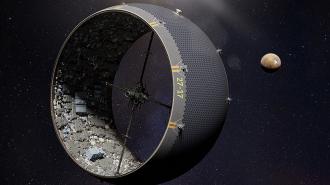Okay, look, they know their paper is a bit … out there.
But what are a bunch of physicists to do when a pandemic grinds the world to a halt if not work on something “wildly theoretical,” as they put it? And there’s few things more aptly described as such than an asteroid city.
Even more wild: they’ve got an idea they think — and the math says — could work (if we are ever in a position to do it).
“Our paper lives on the edge of science and science fiction,” University of Rochester professor of physics and astronomy Adam Frank said. “We’re taking a science fiction idea that has been very popular recently — in TV shows like Amazon’s The Expanse — and offering a new path for using an asteroid to build a city in space.”
University of Rochester researchers have come up with a way to build an asteroid city.
You spin me right round: Picture, in your mind’s eye, a space settlement, the dream of the Bezos and Musks of the world. If you watch enough scifi, you likely envision a rotating mass, whose constant, precisely controlled motion creates simulated gravity for its denizens.
Such a moving metropolis is called an “O’Neill cylinder,” named for physicist Gerard O’Neill, who designed them at the bequest of NASA in the 1970s. Since its conception, the O’Neill cylinder has since become among the most popular of space city ideas, popping up in numerous science fiction pieces and even being touted by the current figures of the new space age. (Jeff Bezos touted their use, drawing a humorous rebuke from Elon Musk, who deemed the idea “like trying to build the USA in the middle of the Atlantic Ocean.”)
One of the largest hurdles to creating O’Neill cylinders would be the sheer cost of their construction. Getting the building materials — and labor — from Earth to space would be exceedingly expensive.
A partial solution could be building an asteroid city, taking advantage of the rocky bodies already out there, building upon them, and then setting them spinning.
“All those flying mountains whirling around the sun might provide a faster, cheaper, and more effective path to space cities,” Frank said. Their abundance and rock layer, which could protect from space radiation, further make an asteroid city an attractive candidate.
But the team found a problem with this plan too when they ran the math: the asteroids will break apart well before they hit the speeds needed to keep our feet on the ground. And on top of that, most asteroids are less “chunk of rock” than “loosely assembled pile of rocks.”
Their answer: a giant bag. Specifically, a giant, flexible, and lightweight mesh bag made from carbon nanofibers.
In the bag: Frank and fellow U of R colleagues and students Peter Miklavčič, Alice Quillen, John Siu, Esteban Wright, Alex Debrecht, and Hesam Askari decided to turn their attention to the problem while locked down for COVID-19.
“This project started as just a way for physicists and engineers to blow off steam, set aside worldly stresses for a while, and imagine something crazy,” Miklavčič, the study’s first author, said.
By running the math on the various forces and material necessary for building an asteroid city with different techniques, they hit on a possible — albeit science-fantastical — solution.
Their answer, published in Frontiers in Astronomy and Space Sciences (frontiers indeed!), is a giant bag.
Specifically, a giant, flexible, and lightweight mesh bag made from carbon nanofibers — tubes only a few atoms in diameter — each with a strength that belies their small size.
“A cylindrical containment bag constructed from carbon nanotubes would be extremely light relative to the mass of the asteroid rubble and the habitat, yet strong enough to hold everything together,” Miklavčič said. And carbon nanotubes are currently being developed in labs around the world with an eye to scale, Miklavčič noted.
The idea may look something like this: You cover the asteroid in the bag. You set the asteroid spinning to create gravity. The bag catches the rubble being flung off as a result, creating a layer of rock thick enough to protect from radiation, and you’ve got yourself a set up for your asteroid city.
Easy, right?
“Based on our calculations, a 300-meter-diameter asteroid just a few football fields across could be expanded into a cylindrical space habitat with about 22 square miles of living area,” Frank said. “That’s roughly the size of Manhattan.”
“Our paper lives on the edge of science and science fiction.”
Adam Frank
Futurist speculation: Of course, all of this is so far down the pike that it’s difficult to imagine as anything other than fantasy. But their study appears to show that building an asteroid city of this kind is possible — though whether or not we’ll ever be able to try it is a different question.
“The idea of asteroid cities might seem too distant until you realize that in 1900 no one had ever flown in an airplane, yet right this minute thousands of people are sitting comfortably in chairs as they hurdle at hundreds of miles an hour, miles above the ground,” Frank said.
“Space cities might seem like a fantasy now, but history shows that a century or so of technological progress can make impossible things possible.”
We’d love to hear from you! If you have a comment about this article or if you have a tip for a future Freethink story, please email us at [email protected].




